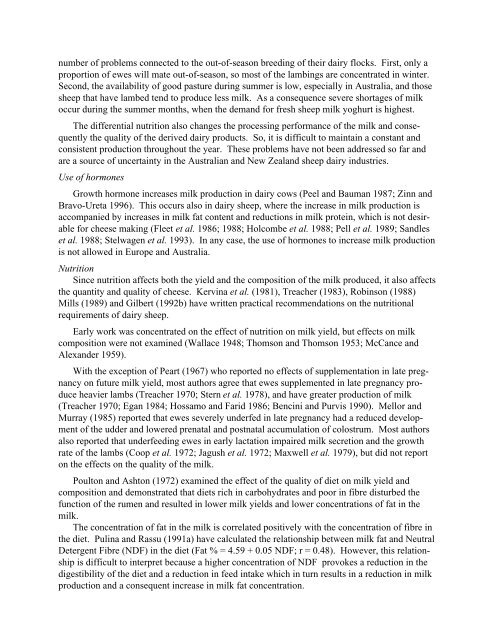Dairy Sheep Symposium - the Department of Animal Sciences ...
Dairy Sheep Symposium - the Department of Animal Sciences ...
Dairy Sheep Symposium - the Department of Animal Sciences ...
You also want an ePaper? Increase the reach of your titles
YUMPU automatically turns print PDFs into web optimized ePapers that Google loves.
number <strong>of</strong> problems connected to <strong>the</strong> out-<strong>of</strong>-season breeding <strong>of</strong> <strong>the</strong>ir dairy flocks. First, only a<br />
proportion <strong>of</strong> ewes will mate out-<strong>of</strong>-season, so most <strong>of</strong> <strong>the</strong> lambings are concentrated in winter.<br />
Second, <strong>the</strong> availability <strong>of</strong> good pasture during summer is low, especially in Australia, and those<br />
sheep that have lambed tend to produce less milk. As a consequence severe shortages <strong>of</strong> milk<br />
occur during <strong>the</strong> summer months, when <strong>the</strong> demand for fresh sheep milk yoghurt is highest.<br />
The differential nutrition also changes <strong>the</strong> processing performance <strong>of</strong> <strong>the</strong> milk and consequently<br />
<strong>the</strong> quality <strong>of</strong> <strong>the</strong> derived dairy products. So, it is difficult to maintain a constant and<br />
consistent production throughout <strong>the</strong> year. These problems have not been addressed so far and<br />
are a source <strong>of</strong> uncertainty in <strong>the</strong> Australian and New Zealand sheep dairy industries.<br />
Use <strong>of</strong> hormones<br />
Growth hormone increases milk production in dairy cows (Peel and Bauman 1987; Zinn and<br />
Bravo-Ureta 1996). This occurs also in dairy sheep, where <strong>the</strong> increase in milk production is<br />
accompanied by increases in milk fat content and reductions in milk protein, which is not desirable<br />
for cheese making (Fleet et al. 1986; 1988; Holcombe et al. 1988; Pell et al. 1989; Sandles<br />
et al. 1988; Stelwagen et al. 1993). In any case, <strong>the</strong> use <strong>of</strong> hormones to increase milk production<br />
is not allowed in Europe and Australia.<br />
Nutrition<br />
Since nutrition affects both <strong>the</strong> yield and <strong>the</strong> composition <strong>of</strong> <strong>the</strong> milk produced, it also affects<br />
<strong>the</strong> quantity and quality <strong>of</strong> cheese. Kervina et al. (1981), Treacher (1983), Robinson (1988)<br />
Mills (1989) and Gilbert (1992b) have written practical recommendations on <strong>the</strong> nutritional<br />
requirements <strong>of</strong> dairy sheep.<br />
Early work was concentrated on <strong>the</strong> effect <strong>of</strong> nutrition on milk yield, but effects on milk<br />
composition were not examined (Wallace 1948; Thomson and Thomson 1953; McCance and<br />
Alexander 1959).<br />
With <strong>the</strong> exception <strong>of</strong> Peart (1967) who reported no effects <strong>of</strong> supplementation in late pregnancy<br />
on future milk yield, most authors agree that ewes supplemented in late pregnancy produce<br />
heavier lambs (Treacher 1970; Stern et al. 1978), and have greater production <strong>of</strong> milk<br />
(Treacher 1970; Egan 1984; Hossamo and Farid 1986; Bencini and Purvis 1990). Mellor and<br />
Murray (1985) reported that ewes severely underfed in late pregnancy had a reduced development<br />
<strong>of</strong> <strong>the</strong> udder and lowered prenatal and postnatal accumulation <strong>of</strong> colostrum. Most authors<br />
also reported that underfeeding ewes in early lactation impaired milk secretion and <strong>the</strong> growth<br />
rate <strong>of</strong> <strong>the</strong> lambs (Coop et al. 1972; Jagush et al. 1972; Maxwell et al. 1979), but did not report<br />
on <strong>the</strong> effects on <strong>the</strong> quality <strong>of</strong> <strong>the</strong> milk.<br />
Poulton and Ashton (1972) examined <strong>the</strong> effect <strong>of</strong> <strong>the</strong> quality <strong>of</strong> diet on milk yield and<br />
composition and demonstrated that diets rich in carbohydrates and poor in fibre disturbed <strong>the</strong><br />
function <strong>of</strong> <strong>the</strong> rumen and resulted in lower milk yields and lower concentrations <strong>of</strong> fat in <strong>the</strong><br />
milk.<br />
The concentration <strong>of</strong> fat in <strong>the</strong> milk is correlated positively with <strong>the</strong> concentration <strong>of</strong> fibre in<br />
<strong>the</strong> diet. Pulina and Rassu (1991a) have calculated <strong>the</strong> relationship between milk fat and Neutral<br />
Detergent Fibre (NDF) in <strong>the</strong> diet (Fat % = 4.59 + 0.05 NDF; r = 0.48). However, this relationship<br />
is difficult to interpret because a higher concentration <strong>of</strong> NDF provokes a reduction in <strong>the</strong><br />
digestibility <strong>of</strong> <strong>the</strong> diet and a reduction in feed intake which in turn results in a reduction in milk<br />
production and a consequent increase in milk fat concentration.
















